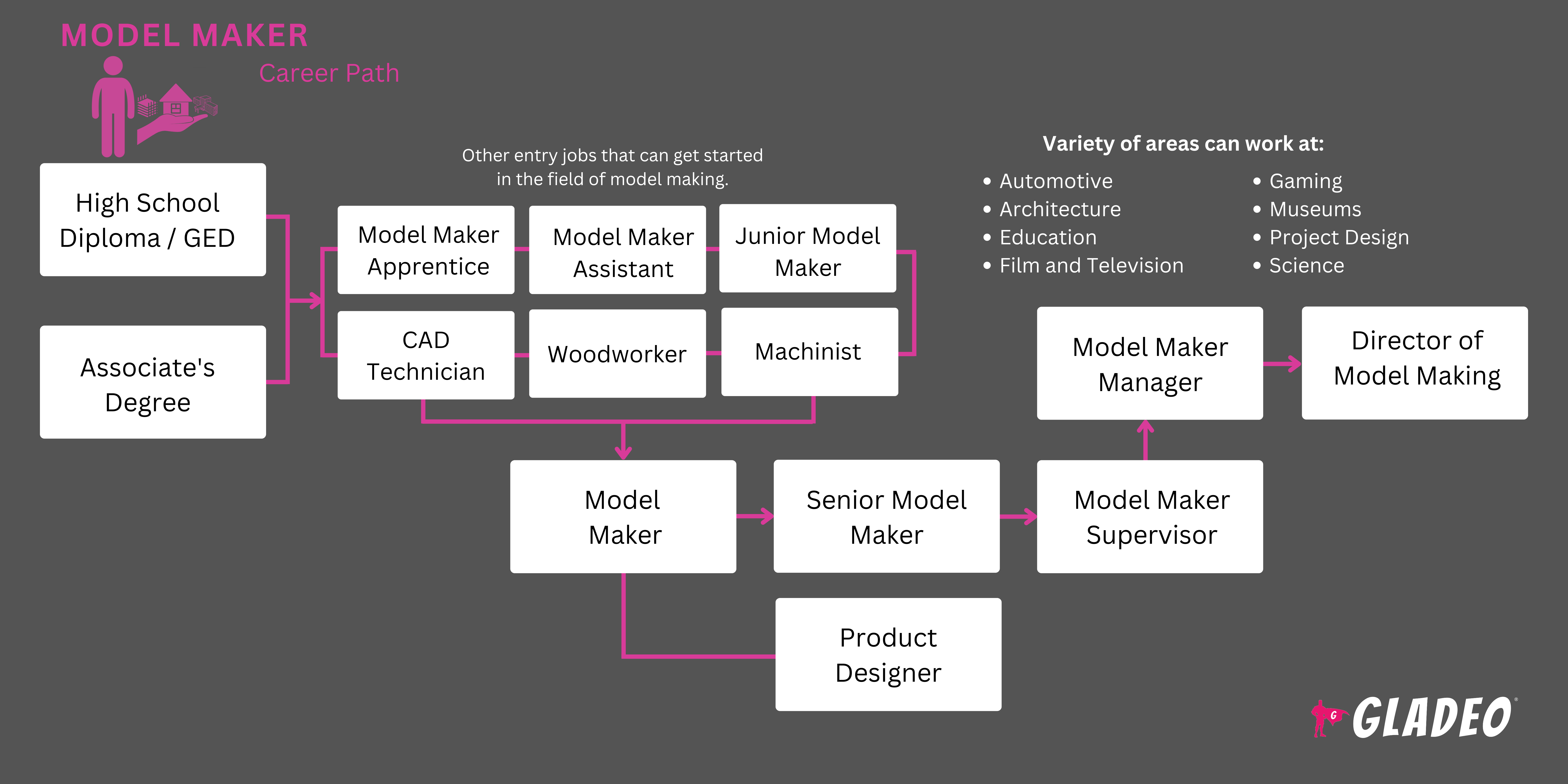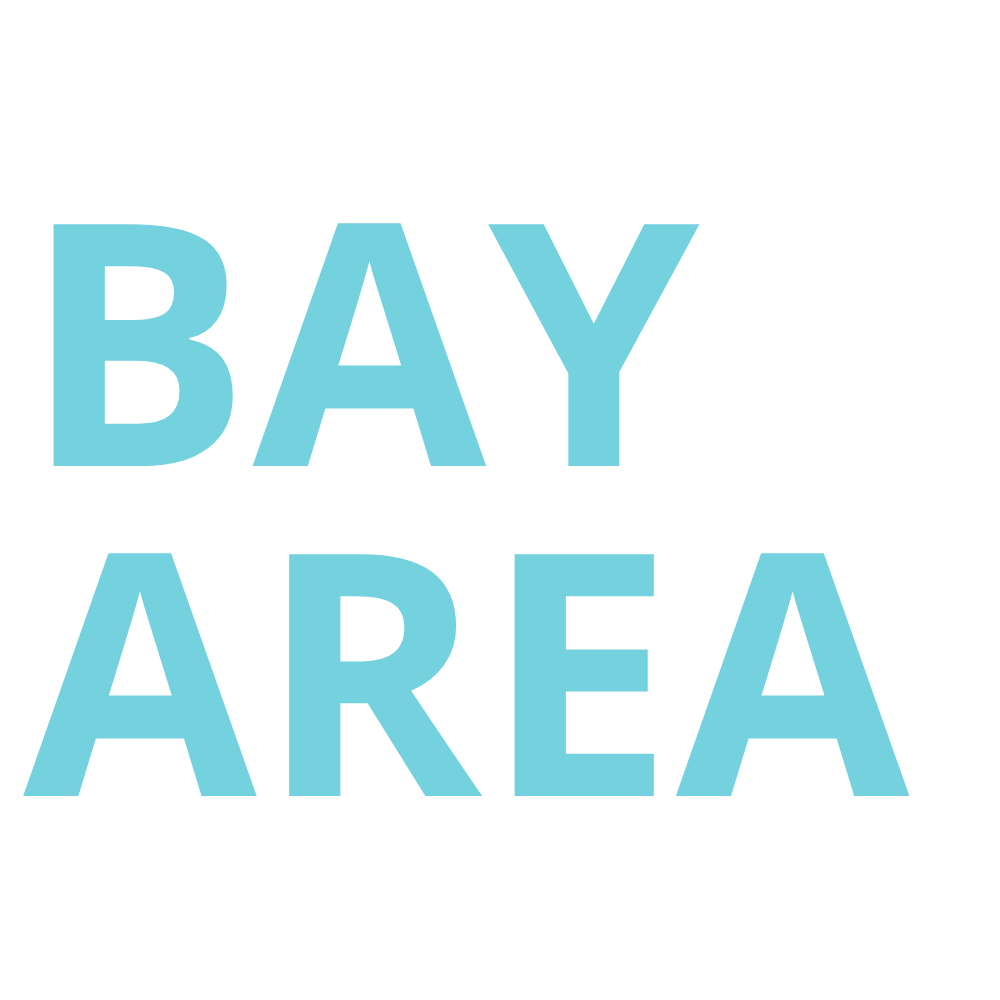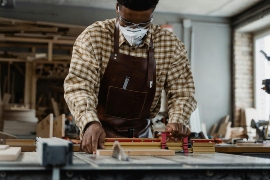Focos
Artesano, constructor de maquetas, fabricante de maquetas, carpintero de desarrollo de productos, constructor de muestras, fabricante de muestras, trabajador de muestras, fabricante de maquetas a escala, especialista en prototipos de diseño, fabricante de prototipos.
Cuando pensamos en modelos, quizá nos vengan a la mente los pequeños coches o trenes en miniatura que a los aficionados les gusta montar. ¡Pero los modelos desempeñan funciones importantes en varios sectores, como la arquitectura, la ingeniería automovilística y la fabricación industrial!
En la industria manufacturera, por ejemplo, antes de que un producto esté listo para su producción en masa y su envío a las tiendas, debe someterse a pruebas. Parte de ese proceso consiste en construir prototipos y maquetas para demostrar que el diseño del producto funciona en la vida real. A continuación, los modelos se someten a rigurosos controles de calidad y facilidad de uso antes de ser aprobados para su producción.
Estos modelos detallados de productos son cuidadosamente elaborados por modelistas para ofrecer a las partes interesadas y a los evaluadores algo que puedan ver, tocar y probar por sí mismos. Los modelos son fundamentales para proporcionar una «prueba de concepto» y para revelar cualquier problema subyacente que pueda requerir ajustes o rediseños.
En estrecha colaboración con diseñadores e ingenieros, los modelistas se aseguran de que sus modelos terminados representen con precisión el diseño y la función previstos dentro de los parámetros solicitados. Utilizan herramientas manuales y manejan una amplia gama de máquinas para crear piezas de precisión a partir de materiales como madera, plásticos y metales. También incorporan otros componentes, como dispositivos electrónicos internos, según sea necesario.
Aunque se trata de un campo profesional relativamente pequeño, los modelistas desempeñan un papel fundamental en la industria manufacturera. Sin su arduo trabajo y diligencia, no tendríamos ni la mitad de los productos que utilizamos y en los que confiamos cada día.
- Dar vida a las ideas mediante modelos físicos
- Contribuir al desarrollo y la innovación de productos.
- Oportunidades para trabajar con tecnologías de fabricación avanzadas.
- Colaboración con profesionales creativos y técnicos
Horario de trabajo
- Los modelistas suelen trabajar a tiempo completo en talleres, instalaciones de fabricación o estudios de diseño. Es posible que sus horarios tengan que ser flexibles para adaptarse a los plazos y ciclos de producción.
Funciones típicas
- Examinar dibujos, planos y especificaciones técnicas de los modelos propuestos.
- Colaborar con ingenieros y diseñadores para ajustar los diseños, según sea necesario.
- Utilizar software CAD y CAM para modificar elementos de diseño.
- Determinar las dimensiones de los materiales necesarios para construir los modelos.
- Determinar el equipo necesario y planificar la secuencia de operaciones.
- Programar máquinas CNC para fabricar piezas de modelos, o colaborar con operarios u operadores de máquinas CNC.
- Ajuste los componentes de la máquina, como cuchillas, accesorios de sujeción, etc.
- Determine qué tipos de piezas en bruto utilizar para crear una pieza de trabajo. Verifique la tolerancia de los materiales que se van a mecanizar.
- Operar máquinas tales como tornos, sierras, prensas, etc. para crear piezas o moldes.
- Marque las pautas y los puntos de referencia en los materiales. Utilice patrones u otras referencias, según sea necesario.
- Utilizar herramientas manuales, limas, amoladoras, lijadoras, martillos, matrices, moldes, plantillas y otras herramientas, según sea necesario, para dar forma y alisar las piezas de trabajo hasta alcanzar las dimensiones requeridas.
- Utilice herramientas eléctricas para perforar agujeros en las piezas.
- Alinee y una las piezas utilizando pernos y tornillos, o mediante soldadura o encolado.
- Inserte componentes mecánicos, eléctricos y electrónicos en los modelos, asegurándose de que el cableado y la soldadura sean correctos.
- Revisar los artículos en busca de defectos. Realizar los ajustes necesarios en la maquinaria.
- Utilice instrumentos de medición para determinar las dimensiones de las piezas fabricadas finales. Verifique que los productos terminados cumplan con los requisitos.
- Probar los prototipos para verificar su correcto funcionamiento.
- Reelaborar las piezas según sea necesario para garantizar que cumplan con los estándares.
- Presentar los modelos a las partes interesadas para obtener comentarios y aprobación.
Responsabilidades adicionales
- Lleve un registro de todos los detalles, como los materiales utilizados, las dimensiones finales de las piezas, los procesos de producción, etc., para garantizar la estandarización en futuros trabajos.
- Mantener y reparar herramientas y equipos.
- Utilice el equipo de protección personal necesario y siga los protocolos de seguridad establecidos.
- Manténgase al día sobre manuales técnicos y nuevas tecnologías.
- Mantener la documentación técnica y las hojas de cálculo con los datos.
- Formar y supervisar a los modelistas junior y a los aprendices.
- Participar en reuniones de desarrollo de productos.
- Garantizar el cumplimiento de las normativas de seguridad y medioambientales.
Habilidades sociales
- Estado de alerta
- Analítico
- Atención al detalle
- Habilidades comunicativas
- Orientado al cumplimiento
- Creatividad
- Pensamiento crítico
- Disciplina
- Independiente
- Observación
- Organización
- Paciencia
- Planificación
- Resolución de problemas
- Resistencia
- Trabajo en equipo
- Gestión del tiempo
Habilidades técnicas
- Software de fabricación asistida por ordenador como Autodesk Fusion 360, SOLIDWORKS, Solid Edge, Siemens NX CAM, GibbsCAM, Mastercam, etc.
- Programas de diseño asistido por ordenador como Autodesk AutoCAD, CATIA, PTC Creo Parametric y SolidCAM.
- Mecanizado por control numérico computarizado (CNC)
- Programas de impresión 3D
- Conocimiento de diversos materiales y sus propiedades.
- Competencia en el uso de herramientas manuales
- Lectura de planos
- Electrónica básica
- Soldadura y soldadura blanda
- Empresas manufactureras
- Empresas de diseño
- Estudios de arquitectura
- Estudios cinematográficos y de entretenimiento
- Empresas de desarrollo de prototipos
- Instituciones educativas
Se espera que los creadores de maquetas produzcan maquetas muy precisas y detalladas dentro de los plazos establecidos. Esto requiere experiencia, precisión y, a menudo, largas horas de trabajo para cumplir con los plazos del proyecto.
El trabajo puede ser físicamente exigente, ya que requiere habilidades motoras finas y atención a los protocolos de seguridad. ¡Pero la satisfacción de convertir un concepto en un producto tangible y funcional puede ser muy gratificante!
La impresión 3D y el software CAD han revolucionado la creación de modelos, permitiendo crear modelos más complejos y reduciendo al mismo tiempo el tiempo y los costes de producción. También se está produciendo un cambio en el sector hacia la sustitución de los materiales tradicionales por alternativas biodegradables o reciclables. Además, las empresas están recurriendo cada vez más a procesos ecológicos que reducen los residuos y el consumo de energía.
Otra tendencia es la integración de la realidad aumentada y virtual, que permite a los diseñadores proyectar modelos digitales en entornos del mundo real o sumergirse en un espacio 3D para interactuar en tiempo real. En cierta medida, estas nuevas tecnologías están reduciendo la necesidad de crear modelos físicos, pero también facilitan mucho la colaboración en proyectos a distancia.
Los modelistas son personas muy prácticas que probablemente hayan disfrutado creando cosas desde pequeños. Es probable que hayan dedicado muchas horas a aficiones como el modelismo, la carpintería o las manualidades. ¡Muchos crecieron con una curiosidad natural por saber cómo se hacen las cosas!
- Los requisitos educativos para convertirse en modelista no son inamovibles.
- Algunos comienzan con un poco de formación profesional o un certificado. Otros pueden obtener un título de asociado o incluso una licenciatura en diseño industrial, tecnología de fabricación o un campo relacionado.
- Las asignaturas comunes del curso incluyen:
- Impresión 3D
- Lectura de planos
- Programación CAM y código G
- Mecanizado CNC
- Diseño asistido por ordenador
- Metrología dimensional
- Procesos de fabricación
- Ciencia de los materiales
- Matemáticas (cálculo, trigonometría, álgebra lineal, geometría, estadística)
- Dibujo técnico mecánico
- Aplicaciones y programación de fresado
- Técnicas de prototipado
- Seguridad en la tienda
- Soldadura y unión de metales
- Muchos modelistas aprenden a través de la experiencia práctica mediante prácticas, aprendizajes o trabajos relacionados.
- Los estudiantes pueden aprender mucho de cursos en línea como el curso de 19 horas Introducción al CAD, CAM y mecanizado CNC práctico de Autodesk , ofrecido a través de Coursera. También hay un curso de cuatro meses de Autodesk CAD/CAM para la especialización en fabricación que incluye un proyecto práctico.
- El conocimiento de las herramientas de realidad aumentada (RA) y realidad virtual (RV) puede mejorar las capacidades y las perspectivas profesionales de un creador de modelos.
- Los modelistas no suelen necesitar una titulación universitaria de cuatro años, pero a menudo cursan estudios relacionados con el CAD, el mecanizado CNC, el diseño industrial, la tecnología de fabricación o campos afines.
- Busca programas con talleres modernos y bien equipados donde puedas adquirir experiencia práctica y aprender sobre las últimas tecnologías.
- Los programas deben contar con profesores con experiencia y, a ser posible, ofrecer oportunidades de prácticas o aprendizaje cooperativo con empresas locales.
- Ten en cuenta el costo de la matrícula, los descuentos y las oportunidades de becas locales (además de la ayuda federal).
- Piensa en tu horario y flexibilidad a la hora de decidir si te matriculas en un programa presencial, online o híbrido. Algunos cursos pueden ser más adecuados para realizarlos en persona y así obtener experiencia práctica.
- ¡Considera también programas que te enseñen a utilizar herramientas de RA y RV en relación con la creación de modelos!
- Inscríbete en muchas clases de matemáticas (aritmética, álgebra, geometría y trigonometría), física, informática, ciencia de los materiales, diseño, arte y taller en la escuela secundaria.
- Considera aprender dibujo técnico y lectura de planos.
- Inscríbete en un programa de un centro de formación profesional o una escuela técnica para aprender sobre CAD, CAM, mecanizado CNC, impresión 3D, soldadura, realidad virtual y otros temas relacionados.
- También puedes realizar cursos online de Coursera, Udemy, edX, Pluralsight, LinkedIn Learning, etc.
- Adquiera experiencia práctica mediante trabajos a tiempo parcial relacionados con el mecanizado o el trabajo en taller.
- Empieza a redactar tu currículum y ve añadiendo información a medida que aprendas y adquieras experiencia laboral.
- Revisa con antelación las ofertas de empleo para ver cuáles son los requisitos medios.
- Solicitud para realizar una entrevista informativa con un modelista en activo.
- Haz una lista de tus contactos (incluyendo direcciones de correo electrónico o números de teléfono) que podrían servir como referencias laborales en el futuro.
- Estudia libros, artículos en línea y tutoriales en vídeo relacionados con la creación de modelos.
- Únete a foros en línea para hacer preguntas y aprender de profesionales con experiencia.
- Participa en clubes y grupos para aprender, compartir, hacer amigos y ampliar tu red de contactos.
- Crea un portafolio de proyectos para mostrar tus habilidades.

- Echa un vistazo a portales de empleo como Indeed, Simply Hired, Glassdoor y Craigslist.
- Adquiere tanta experiencia práctica en el taller como puedas antes de presentar tu solicitud.
- Considera alistarte en el ejército en el campo profesional de la maquinaria. Recibirás formación gratuita remunerada y podrás adquirir experiencia laboral que también podrás utilizar en una carrera civil.
- Busca programas de aprendizaje patrocinados por empleadores, sindicatos o asociaciones comerciales.
- Pide consejos para buscar trabajo a un modelista profesional.
- Considera obtener un certificado o un título de asociado. Las credenciales académicas pueden ayudarte a destacar frente a la competencia.
- Pide ayuda al centro de orientación profesional de tu centro educativo para ponerte en contacto con reclutadores y ferias de empleo.
- Pide con antelación a tus posibles referencias que te recomienden o te escriban cartas de referencia.
- Echa un vistazo a las plantillas de currículum para modelistas disponibles en línea y revisa las posibles preguntas que te pueden hacer en una entrevista de trabajo.
- Antes de acudir a una entrevista, ponte al día sobre las últimas noticias relacionadas con el sector. Prepárate para hablar sobre tus conocimientos acerca de las tendencias y los cambios relevantes.
- Estudie las guías del fabricante y del software. Conviértase en un experto en los programas y máquinas que utiliza.
- Pregunte a su supervisor cómo puede mejorar sus conocimientos y habilidades en CAD, CAM y máquinas CNC para prestar un mejor servicio a la empresa.
- Consigue certificaciones especializadas relacionadas con tecnologías punteras como la RA y la RV.
- Demuestra que puedes trabajar de forma independiente y colaborar eficazmente en equipo.
- Forme a los nuevos trabajadores con paciencia y minuciosidad. Asegúrese de llevar siempre el equipo de protección individual adecuado para evitar accidentes y riesgos.
- Escribe artículos prácticos para consolidarte como líder del sector.
- Diversifica tus habilidades en diferentes tipos de modelismo para ampliar tus horizontes.
- ¡Considera la posibilidad de mudarte si es necesario para avanzar en tu carrera profesional!
Sitios web
- 3Ds Max
- Instituto Americano de Arquitectos
- Asociación Americana de Fabricantes de Moldes
- Asociación para la Tecnología de Fabricación
- Asociación de Ingenieros Energéticos
- Asociación de Fabricantes Profesionales de Maquetas
- AutoCAD
- Autodesk Fusion 360
- Autodesk Inventor
- Licuadora
- CATIA
- Asociación de Fabricantes y Productores
- G2.com
- GrabCAD
- IMAGINEiT
- Sociedad de Diseñadores Industriales de América
- Asociación Internacional de Maquinistas y Trabajadores Aeroespaciales
- Consejo Internacional para la Lubricación de Maquinaria
- Sociedad Internacional de Potencia Fluida
- Sindicato Internacional de Trabajadores del Automóvil, Aeroespacial y Maquinaria Agrícola de Estados Unidos
- Marca:
- Fabricación.gov
- Instituto de Fabricación
- Instituto Nacional de Competencias en Metalurgia
- Asociación Nacional de Herramientas y Maquinaria
- NX – Unigraphics
- Asociación de Productos Mecanizados de Precisión
- Asociación de Conformado de Metales de Precisión
- Revit
- Shapeways
- SketchUp
- Sociedad de Ingenieros de Fabricación
- Borde sólido
- SOLIDWORKS
- Revista TCT
- TITANES del mecanizado CNC
- Sindicato de Trabajadores Siderúrgicos Unidos
- Unidad 3D
Libros
- Hacer que las cosas se muevan: mecanismos DIY para inventores, aficionados y artistas, por Dustyn Roberts.
- Prototipado: guía práctica, por Todd Zaki Warfel
- Prototipado rápido: principios y aplicaciones, por Chua Chee Kai y Leong Kah Fai.
Los modelistas son figuras clave en la industria manufacturera. Sin embargo, este campo profesional es relativamente pequeño y puede que no sea adecuado para todo el mundo, así que echa un vistazo a nuestra lista de ocupaciones relacionadas a continuación para obtener ideas adicionales sobre tu carrera profesional.
- Dibujante arquitectónico
- Técnico CAD
- Programador CNC
- Montador de equipos eléctricos y electrónicos
- Montador de motores
- Diseñador industrial
- Mecánico de maquinaria industrial
- Maquinista
- Ingeniero de fabricación
- Ingeniero mecánico
- Patronista
- Diseñador de productos
- Técnico de prototipos
- Diseñador de escenarios y exposiciones
- Fabricante de estructuras metálicas
- Fabricante de herramientas y matrices
Fuente de noticias

Empleos destacados

Cursos y herramientas en línea

Expectativas salariales anuales
Los nuevos trabajadores comienzan con un salario de alrededor de 60 000 dólares. El salario medio es de 82 000 dólares al año. Los trabajadores con mucha experiencia pueden ganar alrededor de 145 000 dólares.
Expectativas salariales anuales
Los nuevos trabajadores comienzan con un salario de alrededor de 58 000 dólares. El salario medio es de 91 000 dólares al año. Los trabajadores con mucha experiencia pueden ganar alrededor de 91 000 dólares.







